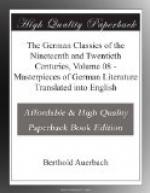Kulturgeschichte, as Riehl used the term, connoted a rather ideal conception, namely, that of an interpretative record of the sum total of human civilization. It required a high challenge like that to energize and unify the requisite laborious research in so many different directions art, letters, science, economics, politics, social life, and what not. The History of Civilization, as understood by Riehl, embraces the results gained in all the special branches of historical study, political history included.
By a formulation so comprehensive and exacting, Riehl himself stood committed to the investigation of the national life not only in the breadth and variety of its general aspect, but also in its minuter processes that had so far been left unheeded. But under his care even the study of seemingly trite details quickened the approach to that fixed ideal of a History of Civilization that should have for its ultimate object nothing less than the revelation of the spirit of history itself. The goal might never be attained, yet the quest for it would at all events disclose “the laws under which racial civilizations germinate, mature, bloom, and perish.”
Personally Riehl applied the bulk of his labors to the two contiguous fields of Folklore and Art History. Folklore (Volkskunde) is here taken in his own definition, namely, as the science which uncovers the recondite causal relations between all perceptible manifestations of a nation’s life and its physical and historical environment. Riehl never lost sight, in any of his distinctions, of that inalienable affinity between land and people; the solidarity of a nation, its very right of existing as a political entity, he derived from homogeneity as to origin, language, custom, habitat. The validity of this view is now generally accepted in theory, while its practical application to science must necessarily depend upon the growth of special knowledge. In The Palatine People Riehl presented a standard treatise upon one of the ethnic types of the German race, an illustration as it were of his own theorems.
Among Riehl’s contributions to the History of Art, the larger number concern the art of music. He was qualified for this work by a sure and sound critical appreciation rooted in thorough technical knowledge. Here again, following his keen scent for the distinguishing racial qualities, he gave his attention mainly to the popular forms of composition; at the same time his penetrating historic insight enabled him to account for the distinctive artistic character of the great composers by a due weighing of their individual attributes against the controlling influences of their time. It is hardly necessary to add that in his reflections music was never detached from its generic connection with the fine arts, inclusive of industrial, decorative, and domestic art.




